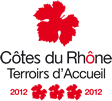SCEA CHATEAU CABRIERES
BP 14
84231 CHATEAUNEUF DU PAPE
CEDEX 1
TEL 04 90 83 70 26
FAX 04 90 83 75 90
contact@chateau-cabrieres.fr
Mon compte


L'ABUS D'ALCOOL EST DANGEREUX POUR LA SANTÉ. À CONSOMMER AVEC MODÉRATION.
Actualités
Actualités

Visite de Mr James Molesworth, rédacteur en chef du Wine Spectator au Château Cabrières.
Publié le dimanche 01 juillet
James Molesworth, rédacteur en chef du Wine Spectator, nous a rendu visite le 20 juin dernier suite aux excellentes notes que la plus célèbre des revues de vins au monde nous avait décernées. Nous lui avons donc fait re-déguster les millésimes 2010 et 2011 et vous trouverez ci-dessous ses commentaires de dégustation.
"Château Cabrières is one of the more prominent historic properties in the appellation, located next to Mont-Redon on the northern side of the appellation. The 74-acre estate features 49 acres in Châteauneuf-du-Pape, most right next to the winery situated on fairly consistent argilo-calcaire soils.
"The terroir of the estate is fairly uniform, parcel to parcel," said Philippe Cambie, the ever-present consultant who has worked here since 2010. "But qualitatively, there are differences because of varying vine age and some different clones used for plantings over the years."
Cabrières, owned by Patrick Vernier, who has been in charge since 2001, produces 7,500 cases annually and sends one-third of its production to the U.S., it's main export market. Among the recent changes here is a newly renovated cellar that was completed in time for the 2010 harvest.
Vinification is minimal and traditional here: The reds are fermented in cement vat after being destemmed almost entirely (85 percent or more), the regular cuvée is aged entirely in vat, and the Prestige cuvée gets some foudre aging.
A sample of Grenache for the 2011 Châteauneuf-du-Pape, from a parcel that forms the bulk of the basic cuvée, has perky acidity, bright cherry and red currant fruit and a lively, floral finish. A second parcel, on similar terroir, shows a chalkier feel, with tauter bitter cherry notes; both lots show potentially very good quality.
In comparison, the 2011 Châteauneuf-du-Pape Prestige is also still in its parts. The first sample is drawn from cement vat and is sourced from some of the estate's oldest vines, which includes some Mourvèdre co-planted with the Grenache in 1900 and 1902. It's taut and sinewy, with good kirsch and red licorice notes and a fine chalky stitching on the finish. It opens up nicely with some air too, showing more flesh. The second parcel, drawn from foudre, is from the same parcel of old vines and it has yet to absorb its wood, with a chestnut flour note lending a dusty edge to the currant fruit. The chalky edge is more buried on the finish but the lively acidity of the vintage is evident. A final sample of Syrah from 2011 shows the variety's affinity for the cooler year, with deep purple color and fresh violet, plum, blueberry and raspberry fruit notes backed by a good spine of chalk. It should give some good heft to the slightly lighter-bodied Grenache.
A clear step up from the 2011 is the 2010 Châteauneuf-du-Pape, which is finished and represents its typical blend of 90 percent Grenache with some Syrah and Cinsault. It's still rather tightly wound, with a dusty, chalky edge coating the cassis, blackberry and plum core. But there's flesh there to soak it up and the fine-grained finish stretches out nicely as it airs in the glass. Though rather closed today, it clearly hints at being a more elegant, mineral-framed expression of Châteauneuf and offers outstanding potential.
The 2010 Châteauneuf-du-Pape Prestige is also bottled and made almost from Grenache with a drop of Mourvèdre. It also shows a firm, chalky coating, along with chestnut leaf, violet and warm stone notes all weaving through the core of ripe cassis and black cherry fruit. The finish is still tight, but it has a sleek feel and impressive length and should stretch out nicely in the cellar. It should easily rival, if not top both the '07 and '09 bottlings, both of which earned 92-point ratings.
The 2011 Châteauneuf-du-Pape White (40 Grenache Blanc, 40 Clairette, 10 Roussanne and 10 Bourboulenc) is made in a plump, forward style, with plantain, pineapple pulp and green almond notes that follow through on the friendly, rounded finish. Offering better length and definition is the 2010 Châteauneuf-du-Pape White which offers a wider range of flavors as well, with lightly toasted almond, brioche, melon and pear backed by a hint of bitter almond on the juicy finish. A portion of the '10 was aged in barrel, as opposed to the '11, while the white accounts for less than 5 percent of the estate's production."
